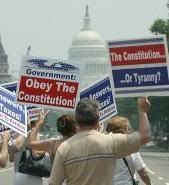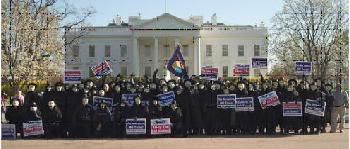Saturday, April 28, 2007
Sign the Ed and Elaine Petition
 (click on image for addresses)
PLEASE WRITE TO Ed & Elaine!
(click on image for addresses)
PLEASE WRITE TO Ed & Elaine!
Let them know that we still care!
To contribute to their commissary accounts,
GO TO the links below and click on "Inmate money page"
Click here to contribute to Ed's commissary account
Click here to contribute to Elaine's commissary account
Click here to read the legal pleadings in Ed & Elaine's case
Click here to read about the great "capstone right" of We The People: our "Right To Petition"
Click here to read about the Right-to-Petition “V” Protest
If you have not already done so, please register an account at MakeTheStand.com so that we may alert you to important news alerts regarding the Ed & Elaine stand.
*****************************
 Business Speaker
Business Speaker
ShowEdTheLaw.com
Aaron Russo RIP
1943 - 2007
Contributors
Previous Posts
- Entire 30 Minute Ron Paul Interview With James Kot...
- The Amero - North American Currency
- American Justice Unmasked! Guess who's Hiding Beh...
- Listeners on Chicago's Q 101 FM Radio Station Have...
- Art Farnsworth Update
- Today's Ed Brown RBN Radio Show Now Online
- Chuck Conces Out Of Jail
- Ed & Elaine On Q101 FM "Live" From Chicago This Mo...
- Congressman Ron Paul Visits My Dorm Room
- Children's Holocaust Illinois & USA Incorporated
Subscribe to
Comments [Atom]










1 Comments:
Ever wonder how so many people can be so evil and so against our cause for freedom, especially those in power. The following is a great book for understanding how ordinary people can group together and become slave masters once the power begins to flow. As with Ed and
Elaine fighting the powers that be, anytime you put power to control in the hands of a few, it only leads to trouble for the rest. For the few dollars this book costs, the inspiration is huge.
Finding Hope in Knowing the Universal Capacity for Evil
"The Lucifer Effect, Understanding How good people turn evil.
http://www.zimbardo.com/current.html
Scenes from his 1971 study at Stanford University in which students were told to be prisoner or guard; the results were echoed at Abu Ghraib.
Dr. Zimbardo, a social psychologist and the past president of the American Psychological Association, has made his reputation studying how people disguise the good and bad in themselves and under what conditions either is expressed.
His Stanford Prison Experiment in 1971, known as the S.P.E. in social science textbooks, showed how anonymity, conformity and boredom can be used to induce sadistic behavior in otherwise wholesome students. More recently, Dr. Zimbardo, 74, has been studying
how policy decisions and individual choices led to abuse at the Abu Ghraib prison in Iraq. The road that took him from Stanford to
Abu Ghraib is described in his new book, “The Lucifer Effect: Understanding How Good People Turn Evil” (Random House).
“I’ve always been curious about the psychology of the person behind the mask,” Dr. Zimbardo said as he displayed his collection.
“When someone is anonymous, it opens the door to all kinds of antisocial behavior, as seen by the Ku Klux Klan.”
http://www.nytimes.com/2007
/04/03/science/
03conv.html?ex=1177905600
&en=432175515d001c47&ei=5070
Q. For those who never studied it in their freshman psychology class, can you describe the Stanford Prison Experiment?
A. In the summer of 1971, we set up a mock prison on the Stanford University campus. We took 23 volunteers and randomly divided
them into two groups. These were normal young men, students. We asked them to act as “prisoners” and “guards” might in a prison
environment. The experiment was to run for two weeks.
By the end of the first day, nothing much was happening. But on the second day, there was a prisoner rebellion. The guards came to me: “What do we do?”
“It’s your prison,” I said, warning them against physical violence. The guards then quickly moved to psychological punishment,
though there was physical abuse, too.
In the ensuing days, the guards became ever more sadistic, denying the prisoners food, water and sleep, shooting them with
fire-extinguisher spray, throwing their blankets into dirt, stripping them naked and dragging rebels across the yard.
How bad did it get? The guards ordered the prisoners to simulate sodomy. Why? Because the guards were bored. Boredom is a powerful
motive for evil. I have no idea how much worse things might have gotten.
Q. Why did you pull the plug on the experiment?
A. On the fifth night, my former graduate student Christina Maslach came by. She witnessed the guards putting bags over the
prisoners’ heads, chain their legs and march them around. Chris ran out in tears. “I’m not sure I want to have anything more to do
with you, if this is the sort of person you are,” she said. “It’s terrible what you’re doing to those boys.” I thought, “Oh my God,
she’s right.”
Q. What’s the difference between your study and the ones performed at Yale in 1961? There, social psychologist Stanley Milgram
ordered his subjects to give what they thought were painful and possibly lethal shocks to complete strangers. Most complied.
A. In a lot of ways, the studies are bookends in our understanding of evil. Milgram quantified the small steps that people take
when they do evil. He showed that an authority can command people to do things they believe they’d never do. I wanted to take that
further. Milgram’s study only looked at one aspect of behavior, obedience to authority, in short 50-minute takes. The S.P.E.,
because it was slated to go for two weeks, was almost like a forerunner of reality television. You could see behavior unfolding
hour by hour, day by day.
Here’s something that’s sort of funny. The first time I spoke publicly about the S.P.E., Stanley Milgram told me: “Your study is
going to take all the ethical heat off of my back. People are now going to say yours is the most unethical study ever, and not
mine.”
Q. From your book, I sense you feel some lingering guilt about organizing “the most unethical study” ever. Do you?
A. When I look back on it, I think, “Why didn’t you stop the cruelty earlier?” To stand back was contrary to my upbringing and
nature.
When I stood back as a noninterfering experimental scientist, I was, in a sense, as drawn into the power of the situation as any
prisoners and guards.
Q. What was your reaction when you first saw those photographs from Abu Ghraib?
A. I was shocked. But not surprised. I immediately flashed on similar pictures from the S.P.E. What particularly bothered me was
that the Pentagon blamed the whole thing on a “few bad apples.” I knew from our experiment, if you put good apples into a bad
situation, you’ll get bad apples.
That was why I was willing to be an expert witness for Sgt. Chip Frederick, who was ultimately sentenced to eight years for his
role at Abu Ghraib. Frederick was the Army reservist who was put in charge of the night shift at Tier 1A, where detainees were
abused. Frederick said, up front, “What I did was wrong, and I don’t understand why I did it.”
Q. Do you understand?
A. Yeah. The situation totally corrupted him. When his reserve unit was first assigned to guard Abu Ghraib, Frederick was exactly
like one of our nice young men in the S.P.E. Three months later, he was exactly like one of our worst guards.
Q. Aren’t you absolving Sergeant Frederick of personal responsibility for his actions?
A. You had the C.I.A., civilian interrogators, military intelligence saying to the Army reservists, “Soften these detainees up for
interrogation.”
Those kinds of vague orders were the equivalent of my saying to the S.P.E. guards, “It’s your prison.” At Abu Ghraib, you didn’t
have higher-ups saying, “You must do these terrible things.” The authorities, I believe, created an environment that gave guards
permission to become abusive — plus one that gave them plausible deniability.
Chip worked 40 days without a single break, 12-hour shifts. The place was overcrowded, filthy, dangerous, under constant
bombardment. All of that will distort judgment, moral reasoning. The bottom line: If you’re going to have a secret interrogation
center in the middle of a war zone, this is going to happen.
Q. You keep using this phrase “the situation” to describe the underlying cause of wrongdoing. What do you mean?
A. That human behavior is more influenced by things outside of us than inside. The “situation” is the external environment. The
inner environment is genes, moral history, religious training. There are times when external circumstances can overwhelm us, and we
do things we never thought. If you’re not aware that this can happen, you can be seduced by evil. We need inoculations against our
own potential for evil. We have to acknowledge it. Then we can change it.
Q. So you disagree with Anne Frank, who wrote in her diary, “I still believe, in spite of everything, that people are truly good at
heart?”
A. That’s not true. Some people can be made into monsters. And the people who abused, and killed her, were.
Post a Comment
Subscribe to Post Comments [Atom]
<< Home